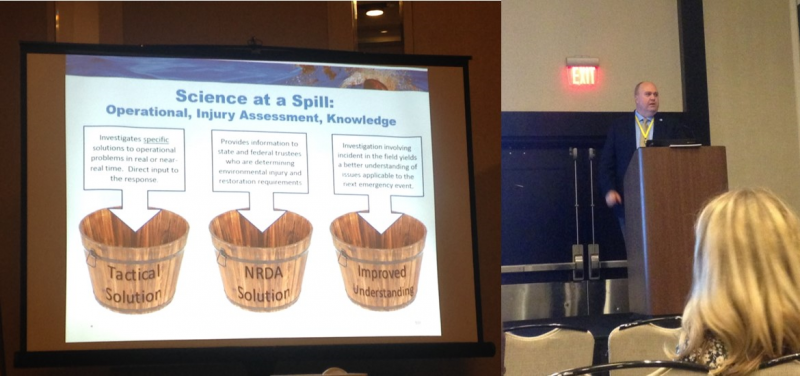
From Feb. 5-8, NOAA staff from throughout the country attended the annual Gulf of Mexico Oil Spill and Ecosystem Science (GoMOSES) Conference in New Orleans. Now in its sixth year, GoMOSES was developed to bring together oil spill-related experts from academia, state and federal agencies, nongovernmental organizations, and industry to share the latest oil spill and ecosystem scientific discoveries, innovations, technologies, and policies. NOAA’s Office of Response and Restoration (OR&R) has been deeply involved with the conference for many years, from serving on the executive committee and moderating sessions to presenting on research and technology.
During the Gulf of Mexico Data Tools Cafe, NOAA displayed a range of tools, including the Environmental Response Management Application (ERMA), an online mapping and visualization tool; the DIVER application, a warehouse that provides access to environmental sampling and analysis data; the Chemical Aquatic Fate and Effects (CAFE) Database, which helps responders in their assessment of environmental impacts from chemical or oil spills into an aquatic environment; and the GNOME Suite for oil spill modeling. Interested conference attendees also had the opportunity to setup and run modeling scenarios in their area of interest using the new web-based user interface for GNOME. Ben Shorr from OR&R’s Assessment and Restoration Division also presented various aspects of DIVER during the session on innovative mainstream designs.
Scott Lundgren, chief of OR&R’s Emergency Response Division, and Charlie Henry, director of the Gulf of Mexico Disaster Response Center, participated in a workshop on “Examining the 1990 Oil Pollution Act to Improve the Governmental and Scientific Response to Future Oil Spill Event.” Scott Lundgren and Charlie Henry presented Oil Pollution Act successes, the coordination of federal research, the integration of operational science, research to support response and assessment, and opportunities and challenges for science integration.

Ed Levine from the Emergency Response Division and Brad Benggio, a NOAA scientific support coordinator based in the Emergency Response Division, took part in another workshop on “Oil Spill Preparedness and Response for Scientists and Researchers: Bridging Science and Response.” Brad Benggio discussed the capabilities and realities of oil spill response, and Ed Levine provided information on the role of scientific support coordinators, who coordinate scientific information and provide critical information to the federal on-scene coordinator during a spill.
The University of New Hampshire’s Coastal Response Research Center held a discussion with the organizing committee and interested GoMOSES attendees on an upcoming workshop titled “Leveraging Science and Academic Engagement.” The organizing committee began development of this event to foster sharing of views on the various models of academic engagement during a response that can inform the Emergency Response Division in the development of plans, training, and exercises. The Office of Response and Restoration also participated in the steering group for the Gulf of Mexico Research Initiative Synthesis and Legacy Initiative, which aims to transfer knowledge to the response, assessment, and restoration communities through workshops and publications.
OR&R staff moderated multiple sessions on Gulf-wide research, marine mammal research, and oil spill modeling. Additionally, OR&R staff reconnected with collaborators, such as the U.S. Coast Guard, The National Academies Gulf Research Program, and various NOAA programs, during poster sessions.
Overall, GoMOSES was a great success. Next year’s conference is scheduled for Feb. 4-7, 2019 in New Orleans, and we look forward to seeing you there!
To view the presentations provided by OR&R staff at GoMOSES, click on the "Related Documents" below.
